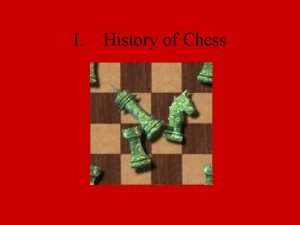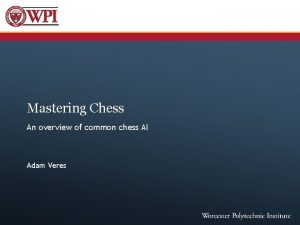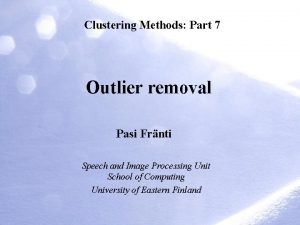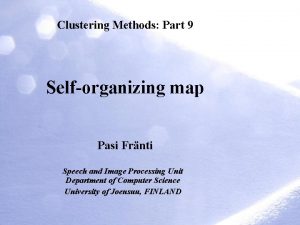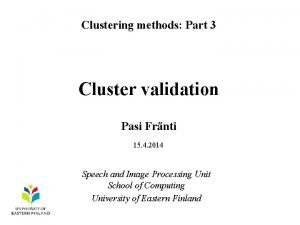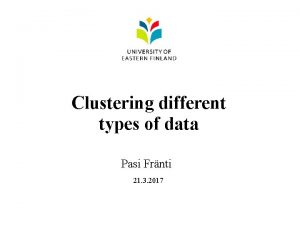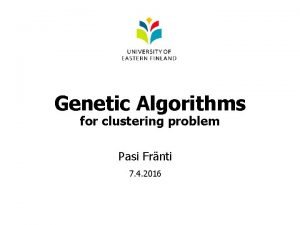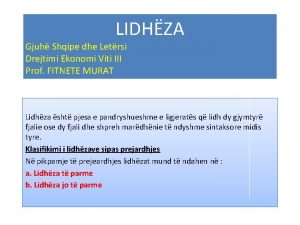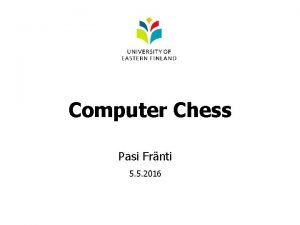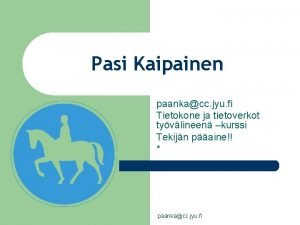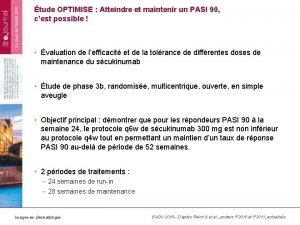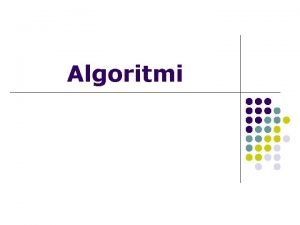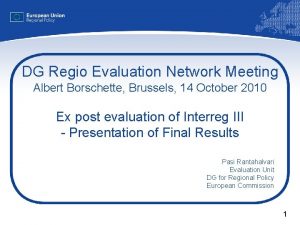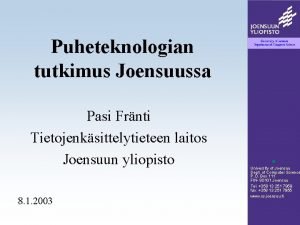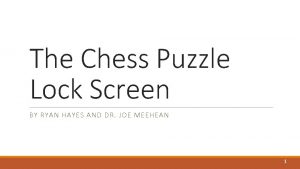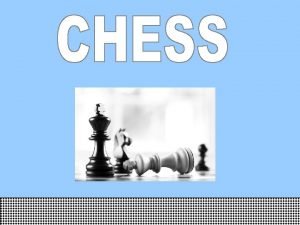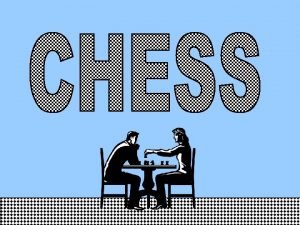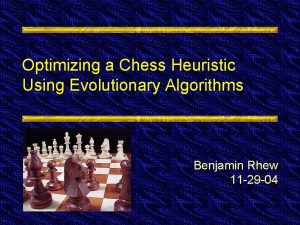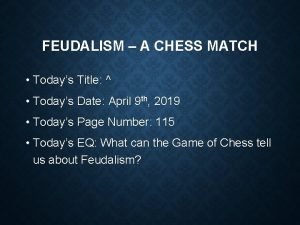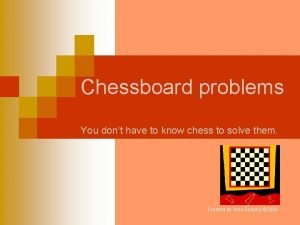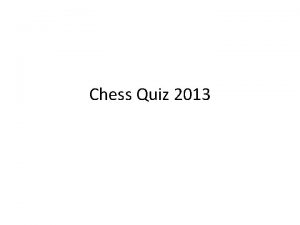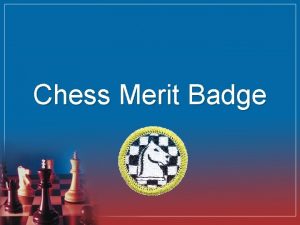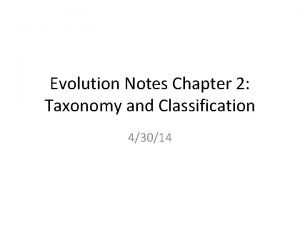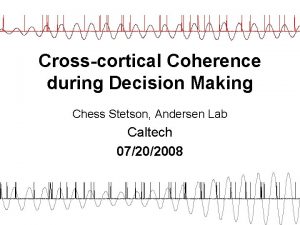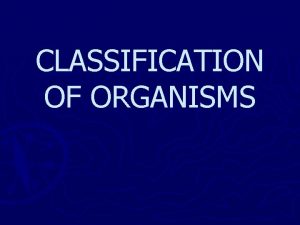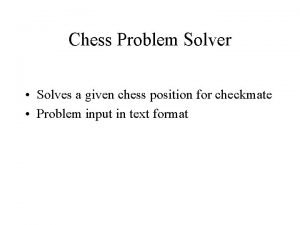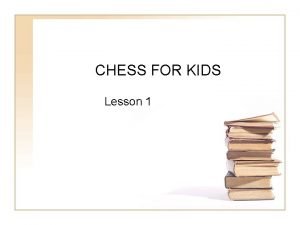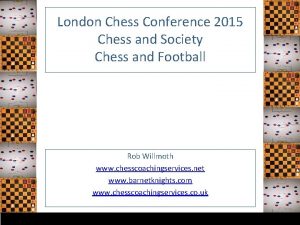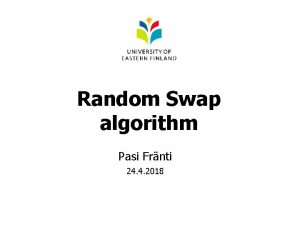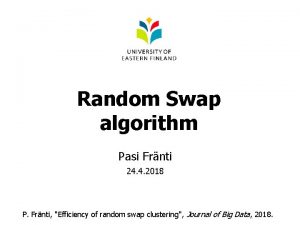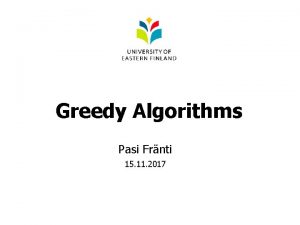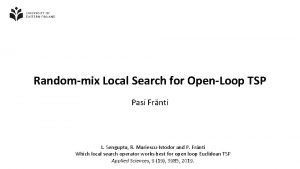Computer Chess Pasi Frnti 5 5 2016 History

![History • • • Mechanical Turk [von Kempelen, 1770] Computer Chess problem and Minmax History • • • Mechanical Turk [von Kempelen, 1770] Computer Chess problem and Minmax](https://slidetodoc.com/presentation_image_h/17fdb83aa667c08646ca4018a2bf3a70/image-2.jpg)


















































![Deep learning (neural network) [-1, +1] Initialization by bootstrapping with only material score Deep learning (neural network) [-1, +1] Initialization by bootstrapping with only material score](https://slidetodoc.com/presentation_image_h/17fdb83aa667c08646ca4018a2bf3a70/image-53.jpg)




- Slides: 57

Computer Chess Pasi Fränti 5. 5. 2016
![History Mechanical Turk von Kempelen 1770 Computer Chess problem and Minmax History • • • Mechanical Turk [von Kempelen, 1770] Computer Chess problem and Minmax](https://slidetodoc.com/presentation_image_h/17fdb83aa667c08646ca4018a2bf3a70/image-2.jpg)
History • • • Mechanical Turk [von Kempelen, 1770] Computer Chess problem and Minmax search [Shannon, 1950] Turings Chess test Deep Blue wins Garry Kasparov [1987] Best computers today (~3200); Magnus Carlsen (2853) Machine learning for optimizing weights of material and positional factors

Pieces and board

Move notations

Minmax search

Chess game as search tree

Minmax search Fixed depth 3 17 2 12 15 25 0 2 5 3 https: //www. youtube. com/watch? v=f. J 4 u. Qpkn 9 V 0 2 14

Material typical values 9 5 3 3 1

Alpha-beta pruning Upper bound Lower bound Terminate when < Max! Min! =3 Max! =2 2 3 Min! 17 2 15 25 0 2 5 3 2 14

Alpha-beta pruning Max! =3 Min! =15 15 3 Max! 3 3 2 17 2 15 15 2 5 3 2 14

Alpha-beta pruning =3 Max! 3 =3 Min! =3 15 3 Max! 3 2 15 =2 2 Min! 3 17 2 15 2 3 2 14

Alpha-beta pruning Final result: 3 3 =3 Max! 3 3 Min! 15 3 3 3 2 17 2 3 2 15 15 2 3 3

Order of moves • Very important! • More accurate value More can be pruned • If branch of best move (oracle!) always searched first, branching factor n • Assume fixed amount of time allowed: d = search dept of minmax e = search dept of alpha-beta n = number of moves d n e n Twice as deep!

Heuristics for ordering • If the same position reached again; use the previous best move to search first again. • If a move was found good in sibling node, then assume it is good also in this node. • Capturing higher value piece = GOOD Capturing defended lower value piece = BAD • Queen promotions

Examples of captures 1. 1. 2. Nxe 5 -2 Bxc 6 Nxe 5 +1 Nxe 5 dxc 6 1. 2. 3. 4. Nxd 5 (+3) cxd 5 (+3) Bxd 5 (+1) Bxd 5 (+3) -2 Qxd 5 (+3) Qxd 5 (+9) Rxd 5 (+9) +1

Horizon effect black to move Two plies search: 1. … Bxh 2 2. Kxh 2 -2 Three plies search: 1. … Nbc 5 2. cxd 7 Nxc 7 -2

Horizon effect black to move Nine ply search: 1. … b 2 2. Bxb 2 c 3 3. Bxc 3 d 4 4. Bxd 4 e 5 5. Bxe 5 f 6 -4

Horizon effect Pushing the disaster beyond horizon Wha blac t can k do ?

Quiescent position Search deeper until quiescent position Non-quiescent situations: – – Winning captures (or any / major capture) Checks + evasions of checks Pawn promotions Pawn move to 7 th rank Earlier used also singular extension

Check is non-quiescent • Material is even • Check is forcing • Black will lose either Queen or another piece

Pawn promotion White to play and win 1. e 7 2. Rb 4 3. Kxc 4! 4. Nxg 6+ 5. Bf 6+ 6. Kd 5+ 7. h 4+ 8. g 4+ 9. Rf 4+ 10. e 4# Qa 3+ Qa 7+ Qxe 7 fxg 6 Qxf 6 Kg 5 Kf 5 hxg 4 Bxf 4

Pawn promotion White wins after 10 moves All moves since e 7 were non-quiescent: • • Check Forced move Capture Threat to promote

Limits of non-quiescent Looks quiet…

Limits of non-quiescent 1. Nf 6+ 2. Qg 4+ 3. Kg 2 gxf 6 Kh 8 Quiet move but…

Limits of non-quiescent Unstoppable: 4. Rh 1 X

Evaluation

Evaluation criteria • • • Material Piece-square tables Pawn structure Piece-specific evaluation Mobility King safety Threat Space Draw-ish-ness

Material Basic values 9 5 3 3 1 Double bishops 6+ Double knights ? ?

Pawn values opening Progress Center important

Pawn values end game

Piece-square table Knight -50, -40, -30, -40, -50, -40, -20, 0, 0, -20, -40, -30, 0, 15, 10, 0, -30, 5, 15, 20, 15, 5, -30, 0, 15, 20, 15, 0, -30, 5, 10, 15, 10, 5, -30, -40, -20, 5, 0, -20, -40, -50, -40, -20, -30, -20, -40, -50,

Piece-square table King during mid-game -30, -40, -40, -50, -50, -40, -40, -30, -20, -30, -40, -30, -20, -10, -20, -20, -10, 20, 0, 0, 20, 20, 30, 10, 30, 20

Piece-square table end game -50, -40, -30, -20, -30, -40, -50, -30, -20, -10, -20, -30, -10, 20, 30, 20, -10, -30, -10, 30, 40, 40, 30, -10, -30, -10, 20, 30, 20, -10, -30, 0, 0, -30, -50, -30, -30, -50

Pawn structure Backward Opposed Lever Passed Unsupported Passed Isolated

Can white promote?

Mobility 4 2 0 1 2 3

King safety

King safety

Transposition table 1. e 4 2. Nf 3 e 5 Nc 6 1. Nf 3 2. e 4 Nc 6 e 5 1. e 4 2. Nf 3 Nc 6 e 5 • Castling rights • En passant moves

Collected examples

Opening + end game databases

Opening book • Known games from grand masters. • Include moves played often. • Systematic self-play by computer until pre-defined depth. • Exclude moves leading to bad position.

Deep Blue – Kasparov 1997 Decisive game 6 Kasparov played h 6… Ne 4 and black has better position Knight sacrifice wins but only if white knows how to play the position. Typical computer chess programs don’t know how to do it.

Deep Blue game 6 Continuation of the game 8. 9. 10. Nxe 6 Qe 7 0 -0 fxe 6 Bg 6+ Nine moves later after 19. c 5 1 -0 black resigns

End game database • Known games from grand masters. • Include moves played often. • Systematic self-play by computer until pre-defined depth. • Exclude moves leading to bad position.

Machine learning

Optimizing by Genetic Algorithm Student project by P. Aksenov (Joensuu, Finland) • • Population of computer players. Random initial parameters. Tournament playing to find fitness. Crossover for new parameter combies.

Initial value range

Result of optimization bishop & knight

Giraffe Student project by M. Lai (London, UK) • Temporal-difference learning: play fixed depth (12 plies). • Fitness based on stability. • Non-linear combination of 363 features. • Optimizes parameters and selection of the next branch in the search.

Giraffe playing strength

Representation
![Deep learning neural network 1 1 Initialization by bootstrapping with only material score Deep learning (neural network) [-1, +1] Initialization by bootstrapping with only material score](https://slidetodoc.com/presentation_image_h/17fdb83aa667c08646ca4018a2bf3a70/image-53.jpg)
Deep learning (neural network) [-1, +1] Initialization by bootstrapping with only material score

Probability-limited search • Traditional: fixed depth with exception of quiescent • Alternative: study deepers when fewer alternatives.

Current computer strengths 2015 • • Grand master International master FIDE master Candidate master >2500 >2400 >2300 >2200

References 1. Monty Newborn (1996): Kasparov versus Deep Blue: Computer Chess Comes of Age, Springer. 2. Feng-hsiung Hsu (2002): Behind Deep Blue: Building the Computer that Defeated the World Chess Champion, Princeton University Press. 3. Petr Aksenov (2004): Genetic algorithms for optimising chess position scoring, MSc thesis, Computer Science, Univ. of Joensuu, Finland. 4. Matthew Lai (2015): Giraffe: Using Deep Reinforcement Learning to Play Chess, Manuscript (submitted). ar. Xiv: 1509. 01549 v 2

Wor ki ng s Giraffe pace
 Shaturanga
Shaturanga Turing program
Turing program Cook's theorem
Cook's theorem Frnti
Frnti Level measure
Level measure Frnti
Frnti Frnti
Frnti Frnti
Frnti Frnti
Frnti Pasi hongisto
Pasi hongisto Frnti
Frnti Frnti
Frnti Frnti
Frnti Frnti
Frnti Frnti
Frnti Frnti
Frnti Regula de 3 secunde
Regula de 3 secunde Dmedi
Dmedi Fjali me lidhezen a
Fjali me lidhezen a Pasi fränti
Pasi fränti Sfs-en 1838
Sfs-en 1838 Pasi kaipainen
Pasi kaipainen Typasi
Typasi Un pasi
Un pasi Pasi puranen
Pasi puranen Notiunea de algoritm
Notiunea de algoritm Psoriatischer marsch
Psoriatischer marsch Nicoletta pasi
Nicoletta pasi Elenger marine
Elenger marine Pasi rantahalvari
Pasi rantahalvari Pasi fränti
Pasi fränti Puzzle lock screen
Puzzle lock screen Chess pieces cheat sheet
Chess pieces cheat sheet Chess piece cheat sheet
Chess piece cheat sheet Sequence diagram for chess game
Sequence diagram for chess game Chess devil
Chess devil Chess heuristic
Chess heuristic Peas description for chess player
Peas description for chess player Chess and the art of enterprise architecture
Chess and the art of enterprise architecture What do the six different chess pieces represent
What do the six different chess pieces represent Game
Game Chess board problem
Chess board problem Chess quiz questions
Chess quiz questions Chess merit badge
Chess merit badge How does the horse move in chess
How does the horse move in chess Journal of neuroscience methods
Journal of neuroscience methods Biodiversity and classification
Biodiversity and classification Dumb kings play chess on fine grained sand
Dumb kings play chess on fine grained sand Napoleon chess set biltmore
Napoleon chess set biltmore Pcm chess
Pcm chess Kings play chess on fat green stools
Kings play chess on fat green stools Chess stetson
Chess stetson Kings play chess on fat guys stomachs
Kings play chess on fat guys stomachs Chess position solver
Chess position solver Chess pieces guide
Chess pieces guide Chess rules for kids
Chess rules for kids Chess autism
Chess autism Complications of local anesthesia in dentistry
Complications of local anesthesia in dentistry
